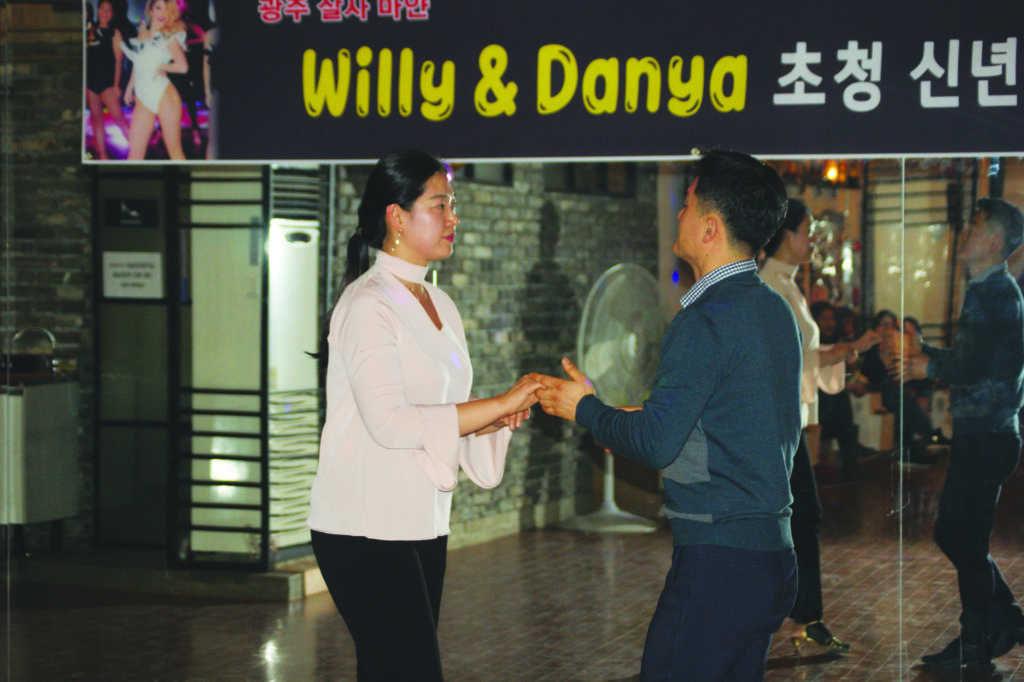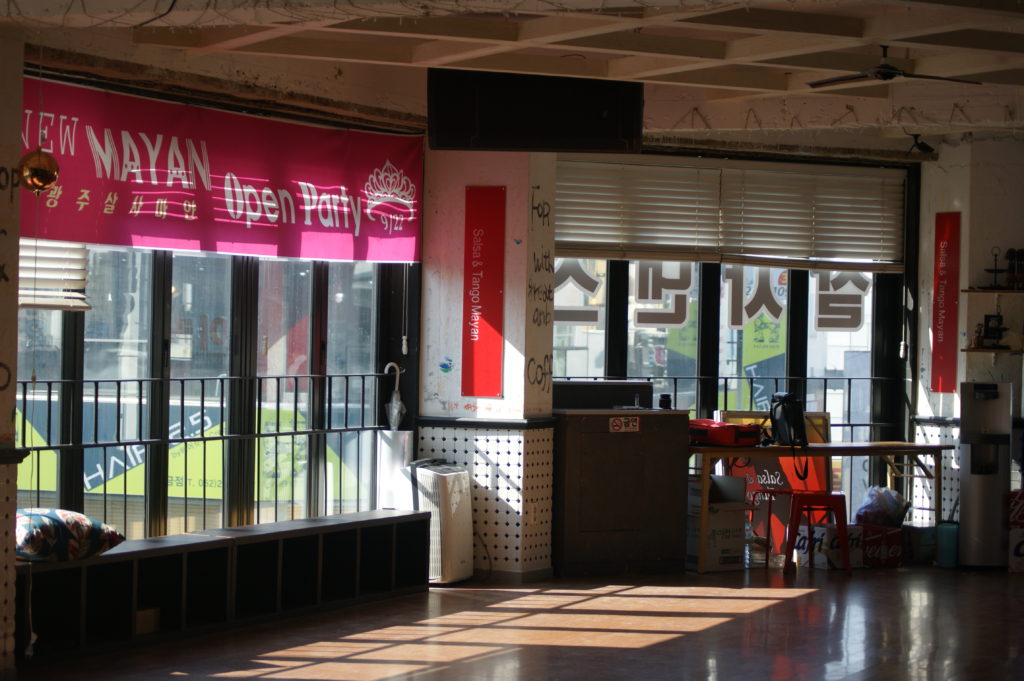Mayan Dance Salsa: A Salsa Dance Studio that Sizzles at Night
Written and photographed by Gianna Francesca Catolico
Mayan Salsa Dance Studio, located in downtown Gwangju, has opened its flaming gates to dancers and aspiring dancers alike since 2002, yet I only discovered its existence recently. Amid the overwhelming popularity and burgeoning influence of Western and Korean pop dances, this modest yet nocturnal studio thrives as the hub of Latin groove in the City of Light.
It’s never too late to learn a new hobby or profession. At the age of 25, Park Soo-young, the studio’s dance instructor, began learning salsa. In the daytime, she manages a guesthouse in Yangrim-dong and, once the sun sets, struts in her heels and sways her body with zestful Latin-American rhythm.

“I learned salsa when I was 25. Since then, I became more interested in salsa and even had some performances in the United States, Singapore, and China,” Park, now 37, told me. After harnessing her salsa skills, she further expanded her Latin dance prowess and is now teaching bachata and kizomba to over 50 students in her studio.
Conceptualized in Angola, kizomba is known for its slow and sensual steps and rhythm. Salsa is a fusion of mambo, Afro-Cuban dance, cha-cha, and other Latin dance forms. Unlike salsa, bachata does not have many turn patterns and is popular for its wake-like movements.
“Bachata is more popular among couples,” Park explained. “Younger Koreans prefer bachata because it’s sexy and beautiful. If they prefer a slower and more emotional dance, there is kizomba or bachata. If they want passion while dancing, and more active [steps], salsa is there.”

She walked us around her studio, a spacious room with comfy furniture, graffiti, a dressing area, and a mini counter for beer and other alcoholic beverages. Displayed on her wall was a bulletin board adorned with snaps of beaming students and guest mentors, trophies that Park had won during her younger days, and posters of her previous and forthcoming gigs. These piqued my interest, and I began quizzing her about them.
“Last month, I invited the famous Mexican duo Willy and Danya to be guest instructors in one of my salsa classes,” Park explained. She makes it a practice to bring a foreign dance instructor once every two or three months. In November last year, a Berlin-based German-Korean dancer organized a two-day kizomba workshop in her studio. Park is now prepping for the Mayan Salsa Dance Studio’s anniversary party, an event that will gather all Latin dancers in Gwangju and nearby cities.
Although her years in the limelight are far from over, Park envisions a fresh roster of enthusiastic and passionate dancers in Latin dance. Today, she trains her protégés to become professional dancers and compete in local and international events. Each class spans up to four hours per week for two months. Likewise, during weekends or special occasions, she entertains almost a hundred partygoers.

Every Tuesday and Sunday, Park teaches kizomba, while every Wednesday and Friday she sways her body to salsa music. All Mondays are slated for bachata classes.
In addition, Park has also expanded her dance tutorial classes outside the gates of her studio. Every Thursday evening, she teaches salsa to eight students in Mokpo.
Some of Park’s students have joined the classes for reasons other than participating in Latin dance competitions. When asked about the reasons behind enrolling in salsa and bachata, Park Ha-jung said she enjoys Latin dance as an after-work hobby. “I think that students searched for salsa classes through Naver or Daum. But for me, I was introduced by my friend. My friend told me, ‘Don’t you want a new hobby? Why don’t you enroll in salsa dance? It’s fun and there’s a party every weekend,’” the 30-year-old teacher said.

Another reason why she chose bachata is because it’s the in-thing among Latin dances. She added, “These days, the trend is to learn bachata. That’s what I heard from other Latin dancers.”
On the other hand, Ji Youn, 25, began her weekly salsa grind last year and recently enrolled in bachata classes. Aside from performing in elegant Latin dance festivals, the dance classes have helped her make new friends. She explained, “I lived in Madagascar for over 20 years and returned to Korea last year. Ever since I started dancing, I’ve made a lot of Korean and foreign friends.”
At the end of our chitchat, Park Soo-young and her loyal students expressed their vision for the Mayan Salsa Dance Studio: to entice more dancers, especially foreigners, to enlist in her classes this year.
“Some foreigners come to the studio and ask, ‘What is this?’ and ‘Can I join?’ Many are curious about the music,” Park Ha-jung chuckled. “It is loud in the evening… We hope more foreigners can come and join us.”
MAYAN SALSA DANCE STUDIO / 마얀 살사댄스
Address: 광주 동구 황금동 84번지 3층
Hwanggeum-dong 84beon-ji (3rd Floor), Dong-gu, Gwangju
Phone: 010-2104-8899
Hours: 8 p.m. onwards
Operating Days: Monday, Tuesday, Wednesday, Friday, Sunday
Fee:
Beginner Salsa (70,000 won/ Foreigners 40,000 won/ month)
Beginner Bachata (40,000 won/ month)
Beginner Kizomba (40,000 won/ month)
Wednesday and Friday dance party (7,000 won)
THE AUTHOR
Gianna Francesca Catolico is an intern at the May 18 Memorial Foundation from the Philippines. She recently finished her Masters in Human Rights and Democratization from Mahidol University in Thailand. She has been sojourning around Asia over the past three years.




